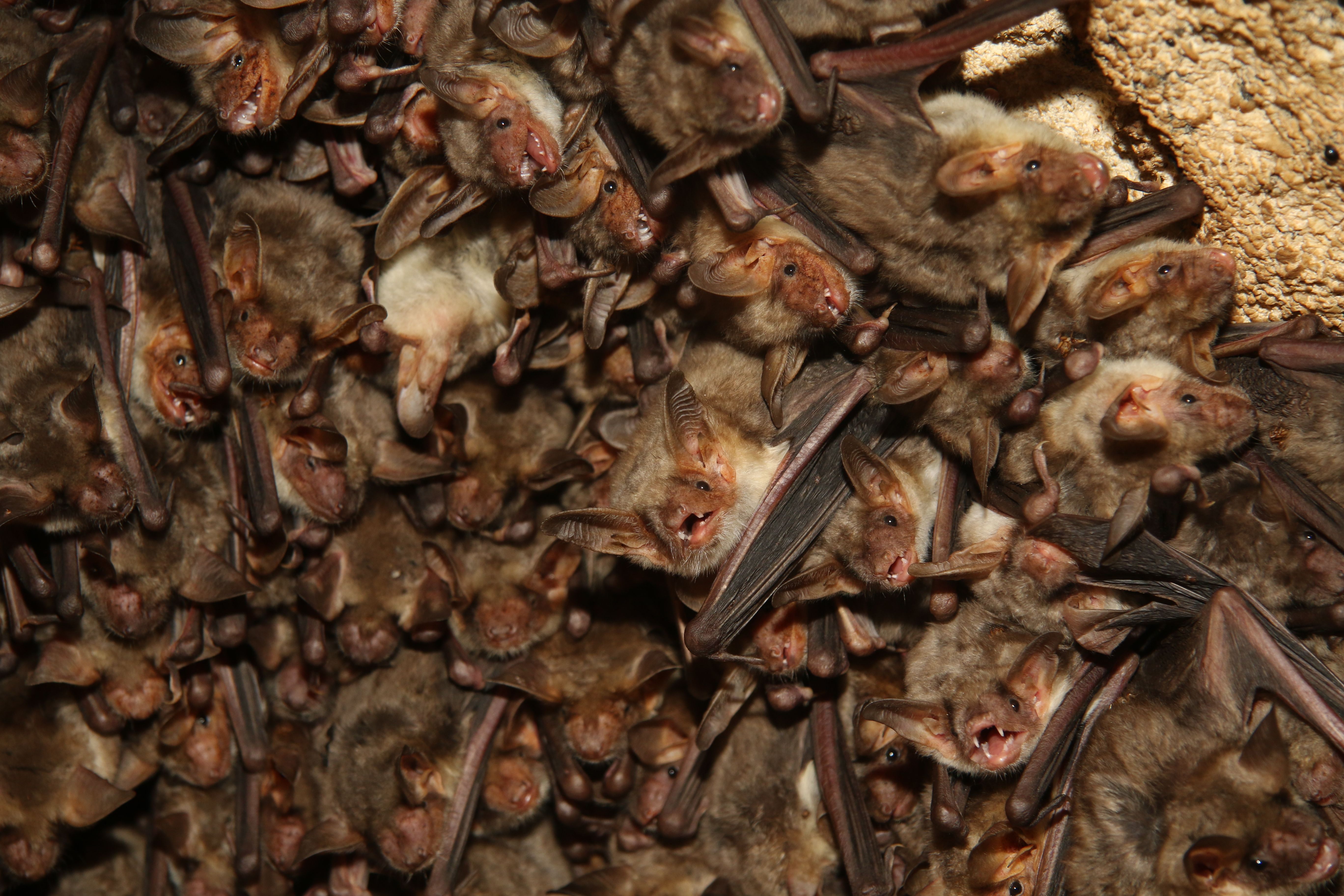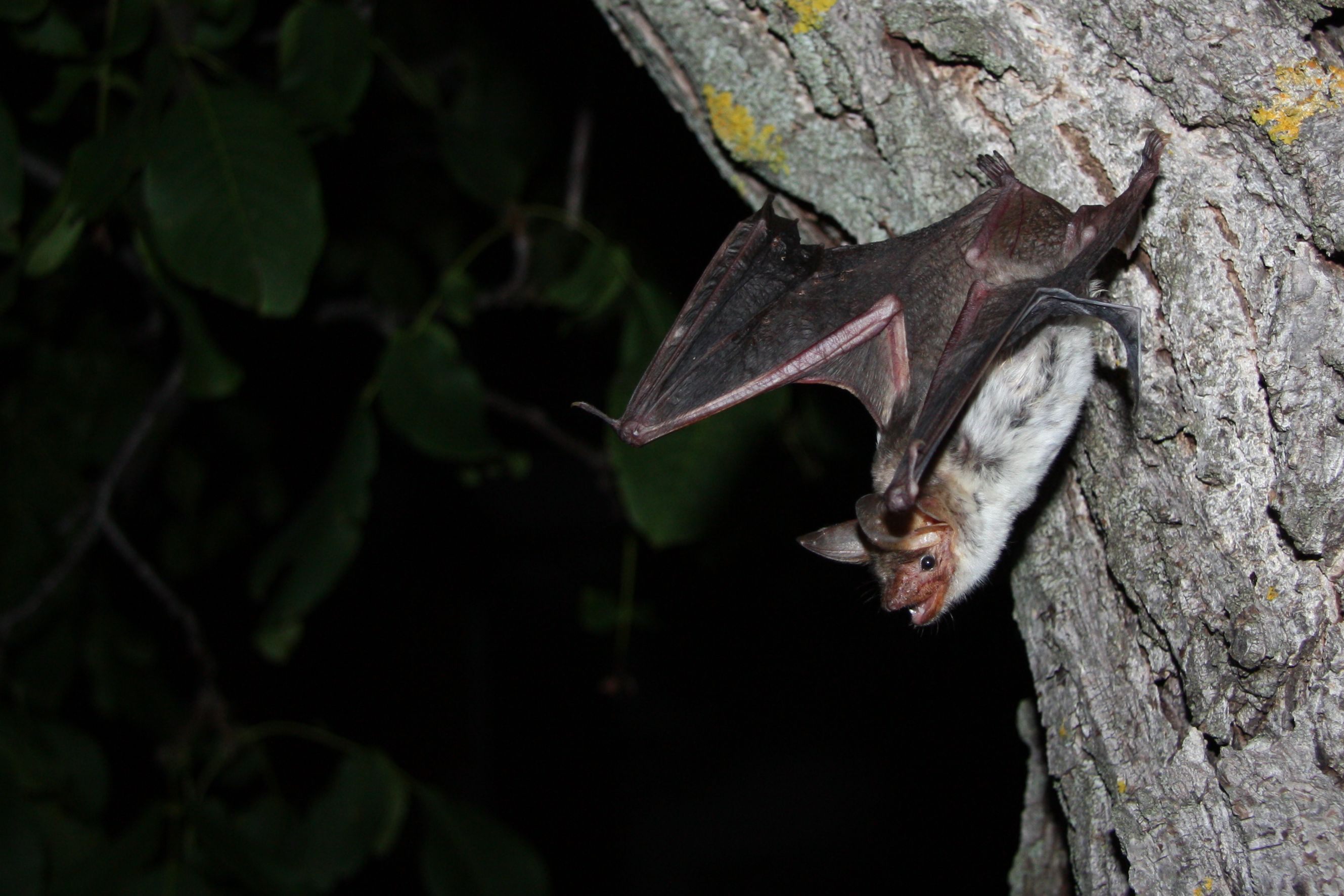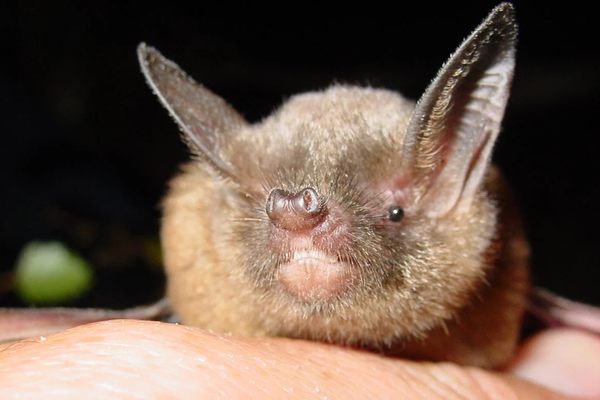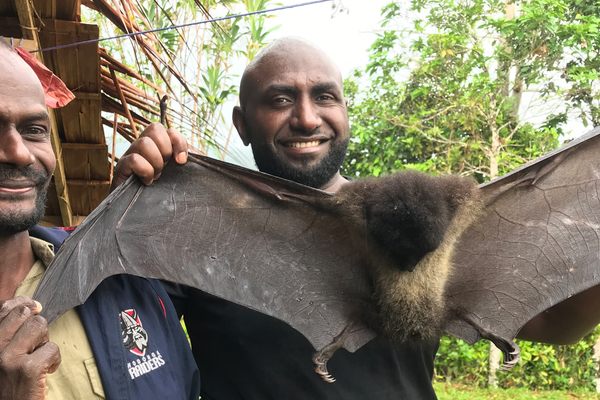Echolocation and Its Discontents
In a world increasingly shaped by humans, having an extra sense can sometimes do more harm than good.

For the past 45 years, volunteers working with Chicago’s Field Museum have spent mornings walking tight circles around McCormick Place, a massive, glassy convention center in the middle of the city. There, they find and collect the many birds that have crashed into the building and died. Over the years, they and other salvage groups around Chicago have collected tens of thousands of birds in this way, and sent their bodies to the Field Museum, to aid in various studies.
Every once in a while, though, the volunteers come across something a little more mammalian: a crumpled bat. Records show that between 1972 and 2003, volunteers found and reported at least 107 dead bats scattered around the building. Still more survived the collision, they noted, but ended up injured or stunned.
We’ve long known why birds fly into buildings: they get dazzled by the urban lightscape, or confuse plate glass for open air. Bats, though, have a particular set of skills. Decades of corrective science have taught us that, despite the idiom, they are far from blind. Many bats can see both at night and during the day, and some can even distinguish colors.

On top of that, they can echolocate, bouncing sound waves off of objects and surfaces to develop extremely precise ideas of where they are and what’s around them. Combined, these two senses form what one science journalist described as “a kind of 20/20 super-vision.” So why do they keep flying into the biggest convention center in North America?
It’s hard to imagine a sense you don’t have, which is one reason it took humans so long to discover echolocation in the first place. In the late 18th century, an Italian scientist named Lazzaro Spallanzani got the ball rolling, undertaking a series of experiments in which he systematically denied bats the ability to use one or more of their senses, and then released them in his pitch-dark bedroom. He scrupulously recorded the results, and found that bats with hoods on crashed into the walls, while bats with opaque discs placed over their eyes flew perfectly.
“My astonishment at this bat which absolutely could see although deprived of its eyes is inexpressible,” Spallanzani wrote after one early experiment, in which he straight-up blinded his poor subject. Inspired by these experiments, some of Spallanzani’s peers plugged bats’ ears or nostrils with pitch, or coated their bodies entirely in grease. Spallanzani came to the conclusion that bat navigation had something to do with a mysterious “sixth sense,” and the mechanisms of echolocation wouldn’t be teased out until 1940, when a biologist named Donald Griffin turned an acoustic receiver on some bats and started picking up high-pitched squeaks.

Even now that we know more about how bats’ senses work, imagining how they actually experience the world requires a kind of robust metaphorical imagination. “The most exciting thing about bats is that they are active-sensing animals,” says Stefan Greif, currently a postdoc researcher at Germany’s Max Planck Institute for Ornithology. Provided there’s enough light around, sighted humans don’t have to do anything in order to see: we do it continuously, as soon as we open our eyes. Bats, on the other hand, “have to emit something—their calls—before they can start perceiving their environment,” Greif explains.
Because these calls are intermittent, bats also have to piece together discrete bits of sound data in order to figure out what’s going on around them. (Picture trying to get around your kitchen at midnight, armed only with a flashlight with a dying battery, Greif suggests.) “It’s not a continuous world,” he says. “It’s more stroboscopic.”
Greif has been studying bats for years. He’s helped to figure out how certain bat species can use light polarization as a kind of compass, and that they actively “eavesdrop” on—and then eat—copulating insects. More recently, though, he’s been preoccupied by another question: is there anything that bats can’t sense properly? “We understand very well how bats perceive small things, like prey or a place they want to land” says Greif. “But it’s hard for us to imagine how they perceive big things, like surfaces, vegetation structures, or habitats.”

Greif had a hunch that bats might rely on a kind of sonic shorthand for these larger problems. “I thought they might have simple rules, like: ‘If it’s smooth underneath me, it’s a water surface,’” he says. And so in 2010, he, like Spallanzani before him, set out to test how his research subjects would fare in a few different artificial situations.
As he and his coauthors explain in a paper in Nature Communications, they first created a small bat obstacle course, placing two metal plates—one rough, one smooth—on the floor of a small flight tunnel. They then had a couple of dozen bats fly through the tunnel, and filmed how they responded when they encountered each plate.
The bats ignored the rough plate. But when they flew over the smooth plate, the authors write, “all 24 bats… spontaneously tried to drink,” swooping down, dipping their heads, and opening their mouths to try and take a sip. The researchers then tried the same scenario with eleven more bats, each a different species. All those bats tried to drink, too. Echolocation is a powerful tool. But in this particular case, it was letting them down. Greif refers to the horizontal plates as a “sensory trap”: a cue that is easily mistaken for something else, sometimes with disastrous results.
At one point during that first study, Greif happened to prop up one of the smooth metal plates vertically against the wall, just to get it out of the way. “Every now and then, behind my back, I heard a ‘Foop!’” he says. “I’d turn around, and a bat would have flown into the smooth surface.” Greif began to suspect he’d found another sensory trap. So in a second study, published last week in Science, he and his research team took their original problem and quite literally flipped it on its head. If bats interpret smooth horizontal expanses as water, they asked, how do they react to smooth surfaces that are vertically oriented instead?
To find out, they made another bat obstacle course inside a flight tunnel, this time with the poster-sized metal plate hung on one wall. They then let 21 greater mouse-eared bats fly one at a time around the tunnel, recording their movements with high-speed cameras, and their calls with an ultrasound microphone. Once again, echolocation failed the bats. Out of all the journeys made to the relevant end of the tunnel, 22.8 percent ended with them slamming into the vertical plate. (The tunnel’s small size ensured that none were injured.)
Analysis of the recordings revealed that this was less a mistaken shorthand and more a kind of echolocation illusion—until they were right next to the plate, the bats thought there was nothing there at all. (Imagine again you’re in the dark with that faulty flashlight again, Greif suggests, but this time you’re approaching a mirror. Unless you’re approaching the mirror dead-on, the flashlight’s beam will get reflected elsewhere, off at an angle, where it’s essentially useless.)

Greif and his colleagues later redid these experiments in the wild, placing similar plates outside of a few different roosts after the bats had left for the night. As the colonies returned home in the morning, multiple bats flew into the plate, like Wile E. Coyote running into one of those false tunnel entrances. Greif also realized he had already been seeing this happen in the wild for years, without realizing it: “In front of one of the caves where we usually try to catch bats, there’s a big metal information plate,” he says. “I noticed that every now and then, some bats collided with it [as they leave the cave]… they look left and right, see an opening, and then fly to the right into the opening, which turns out not to be an opening at all.”
Sensory traps are increasingly common in nature, as manmade structures replace, imitate, or interrupt the natural signs that animals and plants have evolved to recognize. Just-hatched sea turtles, thinking they’re following the moon into the ocean, instead end up under highway streetlights. Birds mistake plate-glass windows for open sky. Moths fly into lamps or flames.

As humans, gifted with a particular set of senses, some of these problems are easy to understand, and therefore somewhat intuitive to solve. Over the past few years, certain beachfront towns have adopted lights-out-after-dark policies during hatching season, and large buildings in some major cities have started doing the same during the spring and fall migrations.
Other ones, though—like these bat mistakes—require a bigger leap to understand. The extent to which artificially smooth surfaces actually confuse or hurt bats has not yet been studied rigorously, and experts have argued that there are much bigger threats to puzzle out, like white nose syndrome and wind turbines. But now that we know this little thing about how bats experience the world, Greif argues, it will be that much easier to make sure that, as we continue to reshape it, we can do our best to keep from confusing them. “My biggest hope from this paper is that people start paying more attention,” he says. We just need multi-species, extra-sensory empathy to do it.






















Follow us on Twitter to get the latest on the world's hidden wonders.
Like us on Facebook to get the latest on the world's hidden wonders.
Follow us on Twitter Like us on Facebook